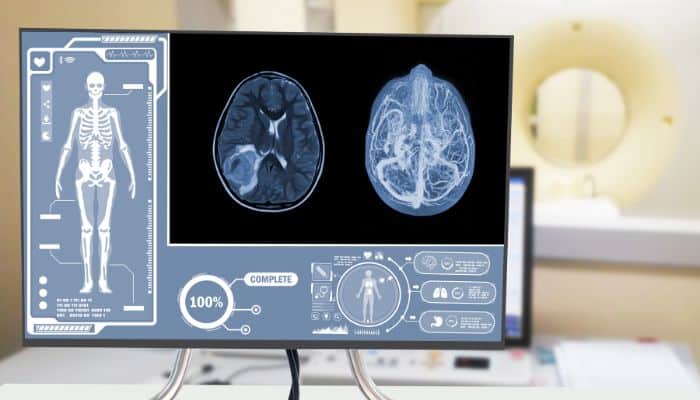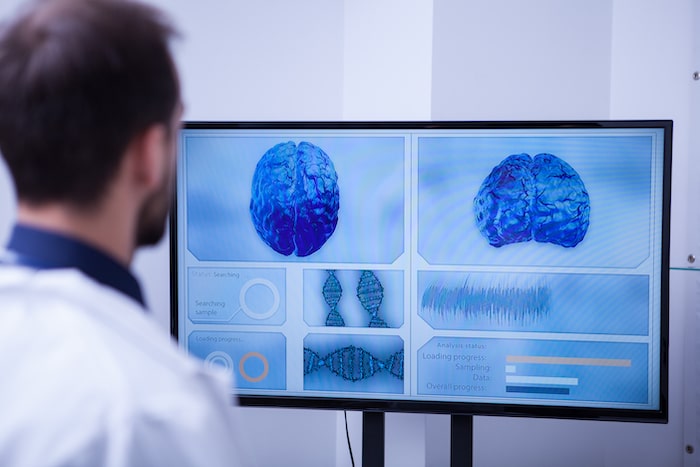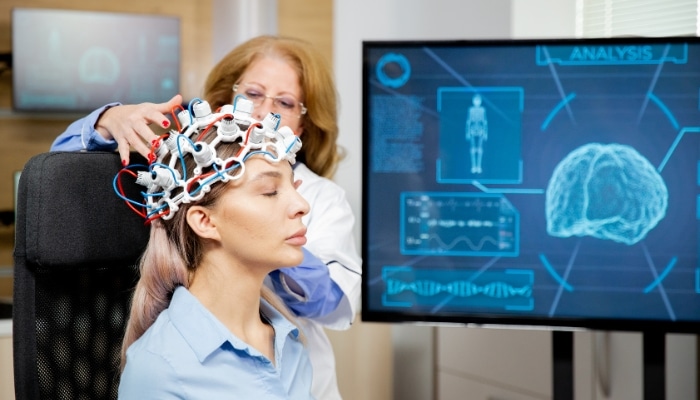4 min read
Understanding MRI: The Revolutionary Imaging Technique

What is a Magnetic Resonance Imaging (MRI)?
Magnetic Resonance Imaging, or MRI, is a fascinating medical imaging technique used in radiology to form pictures of the anatomy and physiological processes of the body. Unlike X-rays or CT scans, MRIs use strong magnetic fields and radio waves to generate detailed images of the inside of your body. This allows doctors to diagnose and monitor many different medical conditions without the need for invasive procedures.
How Does an MRI Work?
MRI machines use a powerful magnet, radio waves, and a computer to create detailed images. When you undergo an MRI, the magnetic field temporarily aligns water molecules in your body. Radio waves then cause these aligned particles to produce faint signals, which are used to create cross-sectional MRI images – like slices in a loaf of bread. The computer then processes these signals to create detailed images of your organs and tissues.
What are the Different Types of MRI?
There are several types of MRI scans, each tailored for a specific purpose. The most common include:
Standard MRI
- Purpose: General imaging.
- Applications: Used to create detailed images of almost any part of the body, including bones, joints, and soft tissues. Ideal for detecting a variety of conditions like tumors, bleeding, injuries, and infections.
- Process: Involves lying still inside the MRI scanner while it captures images.
Functional MRI (fMRI)
- Purpose: Measuring brain activity.
- Applications: Helps in understanding brain function, particularly useful for planning brain surgery or research in brain disorders.
- Process: Detects changes in blood oxygenation and flow that occur in response to neural activity.
Magnetic Resonance Angiography (MRA)
- Purpose: Examining blood vessels.
- Applications: Used to detect, diagnose, and guide the treatment of heart disorders, stroke, and blood vessel diseases.
- Process: Offers clear images of blood vessels without the need for catheters or surgery.
Magnetic Resonance Venography (MRV)
- Purpose: Focusing on veins.
- Applications: Particularly effective for identifying blood clots in the veins.
- Process: Provides detailed images of the body’s veins.
Diffusion MRI
- Purpose: Measuring the diffusion of water molecules in tissue.
- Applications: Highly useful in the early detection of stroke, as it can show areas of the brain affected by ischemia.
- Process: Tracks the random movement of water molecules within the body tissue to provide insights into the cellular environment.

What Can an MRI Diagnose?
MRI (Magnetic Resonance Imaging) is a highly versatile diagnostic tool that can be used to detect and assess a wide range of medical conditions. Due to its ability to produce detailed images of internal body structures, MRI is particularly valuable in identifying issues within the brain, spinal cord, and other areas of the body. Here are some of the key conditions and issues that MRI can help diagnose:
- Brain Tumors, Stroke, and Aneurysms
- MRI is highly effective in imaging the brain, making it a crucial tool for detecting brain tumors.
- It can identify areas of the brain affected by stroke and help in assessing the extent of stroke damage.
- MRI can also detect aneurysms, which are abnormal bulges or ballooning in the wall of an artery in the brain.
- Spinal Cord Injuries
- MRI provides clear images of the spinal cord and surrounding areas, making it ideal for diagnosing spinal cord injuries.
- It can reveal details about the severity and exact location of the injury, which is crucial for treatment planning.
- Multiple Sclerosis
- MRI can detect the changes in the brain and spinal cord associated with multiple sclerosis (MS), a disease that affects the central nervous system.
- It helps in diagnosing MS and monitoring its progression over time.
- Heart Problems
- Cardiac MRI is used to visualize the heart and its structures, providing valuable information about heart anatomy and function.
- It can be used to assess the damage caused by a heart attack or heart disease.
- Liver and Other Abdominal Diseases
- MRI is used to examine organs in the abdomen, including the liver, kidneys, pancreas, and spleen.
- It can detect tumors, liver diseases, and other abdominal conditions.
- Joint and Musculoskeletal Disorders
- MRI is highly effective in imaging joints and soft tissues, such as tendons and ligaments.
- It is commonly used to diagnose joint disorders, sports injuries, and other musculoskeletal problems.
Is an MRI Safe?
MRI is a safe procedure with no known health risks. It doesn’t use ionizing radiation, which is found in X-rays and CT scans. However, it’s important to tell your doctor if you have any metal in your body, like pacemakers, cochlear implants, or certain metal clips, as these can be affected by the magnetic field.

How to Prepare for an MRI?
Preparing for an MRI (Magnetic Resonance Imaging) scan involves a few simple yet important steps to ensure the procedure is safe and the images obtained are of high quality. Here’s what you typically need to do:
- Remove Metal Objects: MRI machines use powerful magnets, so it’s crucial to remove all metal objects from your body. This includes jewelry, watches, hairpins, glasses, hearing aids, dentures, and even underwired bras. Metal can interfere with the magnetic field, affecting the quality of the MRI images.
- Wear Appropriate Clothing: You might be asked to change into a hospital gown to prevent any interference from metal zippers, snaps, or fibers in regular clothing. It’s a good idea to wear clothing that is easy to take off and put back on.
- Inform About Medical and Surgical History: Let your MRI technician know if you have any medical or surgical implants, such as pacemakers, cochlear implants, metal clips, or prosthetic joints. Some implants are MRI-safe, while others may pose a risk.
- Contrast Dye (If Applicable): In some cases, a contrast dye may be injected to enhance the quality of the MRI images. This dye, usually based on gadolinium, helps to highlight certain structures or abnormalities more clearly. If a contrast dye is to be used, you may need to fast for a certain period before the scan. Also, inform the staff if you have any allergies, kidney problems, or a history of adverse reactions to contrast materials.
- Fasting (If Required): Depending on the type of MRI exam, you may be asked to fast for a few hours prior to the procedure. This is particularly common if a contrast dye is to be used or if the abdomen is being imaged.
- Medications: Generally, you can take your regular medications before an MRI. However, confirm this with your doctor or the MRI staff, especially if you are taking any over-the-counter or prescription medications.
- Relaxation and Stillness: During the MRI, it’s important to remain as still as possible to obtain clear images. If you’re claustrophobic or anxious about being in the MRI machine, inform the staff. They might offer you strategies or mild sedatives to help you relax.
- Arrive Early for Preparation: Arriving early for your appointment can provide extra time to complete necessary paperwork, change clothes if needed, and discuss any concerns with the MRI staff.
- Understanding the Procedure: Before the scan, the MRI technician will explain the procedure and what to expect. MRI machines make loud thumping and humming noises, so you may be given earplugs or headphones to help block out the noise.
- Post-Procedure Instructions: Usually, no special care is needed after an MRI. If you’ve received a sedative, you might need someone to drive you home. If a contrast dye was used, it’s often advised to drink plenty of fluids to help flush the dye from your body.
What Happens During the MRI Procedure?
During an MRI (Magnetic Resonance Imaging) procedure, several key things occur to ensure the imaging process is successful and comfortable for the patient. Here’s an overview of what happens:
- Remain Still: It is crucial for the patient to remain as still as possible during the MRI scan. Movement can blur the images, which might lead to the need for repeat scans. For some types of MRIs, you might be asked to hold your breath for short periods.
- Noise During the Scan: MRI machines produce loud tapping, thumping, or buzzing noises while operating. This is normal and is the sound of the MRI machine’s magnets being turned on and off. Most facilities provide earplugs or headphones to help reduce the noise impact, and some may offer music to help you relax.
- Length of the Procedure: The duration of an MRI scan can vary significantly depending on the type of scan and the body part being examined. It typically ranges from 15 minutes to an hour. During this time, it’s important to maintain your position and follow any instructions given by the MRI technician.
- Communication with the Technician: Although you will be inside the MRI scanner, you are usually able to communicate with the MRI technician through a built-in intercom system. If you feel uncomfortable or need assistance at any point during the procedure, you can inform the technician.
- Contrast Dye Injection (If Applicable): If your MRI requires a contrast dye, it will be administered through an IV line. You might feel a cool sensation or minor discomfort during the injection.
- Positioning Inside the Machine: You will lie on a sliding table that gently moves into the MRI scanner. The part of your body being scanned will be positioned in the center of the machine. Some MRI machines are tunnel-like, while others are more open, which can be more comfortable for claustrophobic patients.
- Monitoring: Throughout the procedure, the MRI technician monitors the process from a separate room but can see you through a window and communicate with you.
- After the Procedure: Once the scan is complete, the table will slide out of the scanner. You can then get up, but it’s advisable to do so slowly in case you feel lightheaded.
Conclusion: Key Steps for a Successful MRI Experience
In conclusion, preparing for an MRI scan is a straightforward process that plays a crucial role in ensuring the safety and effectiveness of the procedure. By removing all metal objects, wearing appropriate clothing, and possibly using a contrast dye, patients can help ensure the highest quality of imaging. It’s also important to inform the medical staff of any implants, allergies, or medical conditions that might affect the procedure. Remaining still and relaxed during the scan is key to obtaining clear images. Most MRI scans require no special post-procedure care, allowing patients to resume their normal activities almost immediately. By understanding and following these preparation steps, patients can contribute significantly to the success of their MRI, aiding in accurate diagnoses and effective treatment planning.
